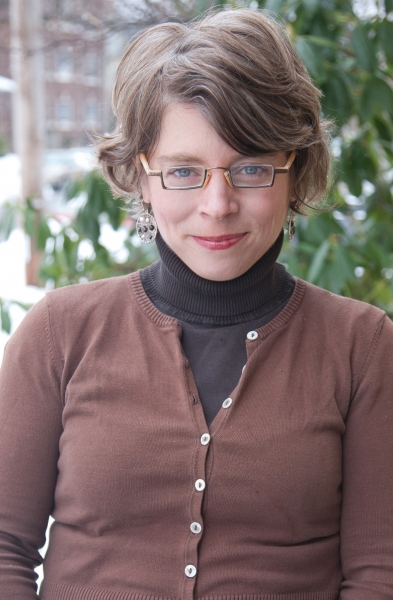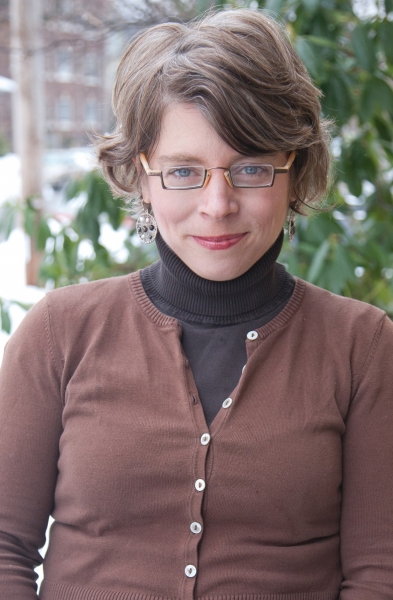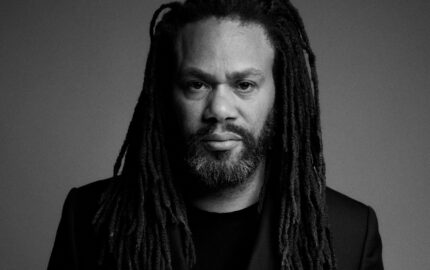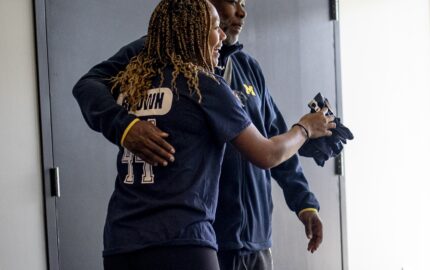 No wonder Jill Lepore describes herself as a "code-switcher." She's both a prize-winning professor of history at Harvard University and a staff writer for The New Yorker magazine. Her most recent book, "Book of Ages: the Life and Opinions of Jane Franklin," was a finalist for the 2013 National Book Award for non-fiction and Lepore was also a finalist for the 2006 Pulitzer Prize in History for "New York Burning: Liberty and Slavery in an Eighteenth-Century City." After speaking recently with the current class of Nieman fellows, Lepore sat down with Storyboard to talk about her upcoming book on the strange and wonderful story behind Wonder Woman (a morsel of which you can read here); what journalists and historians can learn from each other; and that time she didn't footnote the birds. Following are edited excerpts of the conversation:
No wonder Jill Lepore describes herself as a "code-switcher." She's both a prize-winning professor of history at Harvard University and a staff writer for The New Yorker magazine. Her most recent book, "Book of Ages: the Life and Opinions of Jane Franklin," was a finalist for the 2013 National Book Award for non-fiction and Lepore was also a finalist for the 2006 Pulitzer Prize in History for "New York Burning: Liberty and Slavery in an Eighteenth-Century City." After speaking recently with the current class of Nieman fellows, Lepore sat down with Storyboard to talk about her upcoming book on the strange and wonderful story behind Wonder Woman (a morsel of which you can read here); what journalists and historians can learn from each other; and that time she didn't footnote the birds. Following are edited excerpts of the conversation:If you could talk about Wonder Woman first, how did you get that idea and what attracted you to the subject?
Well, I guess not what one would think. I wasn’t a Wonder Woman fan as a kid. I came at from a completely different angle and then I felt compelled to write it because it seemed to me I’d come upon an important discovery, meaningful as a piece of political history, chiefly.
I’m really interested in the history of privacy, and I’d been researching the history of privacy for a while, and I come across William Moulton Marston, because he’s key in the development of what becomes the lie detector test and the polygraph is really important in what becomes the history of privacy. So I spent a good amount of time with Marston and it turns that he also, much later, goes on to create Wonder Woman.
Meanwhile, the news was sort of broken in the 1990s, he had a polyamorous family; he lived with three women by whom he had four children. And that’s just interesting on its own. And then I happened to go to Smith College to do some research for a New Yorker piece I was asked to write on the history of Planned Parenthood. I was interviewing Cecile Richards, who was the president of Planned Parenthood but I was doing some archival work, too. And Margaret Sanger, who founded Planned Parenthood with her sister Ethel Byrne in 1916, her papers are at Smith and so are the papers for Planned Parenthood.
In any case, while I was looking through the Margaret Sanger papers, I kept coming across letters from Olive Byrne, who is Margaret Sanger’s niece, the daughter of Ethel Byrne. And Olive Byrne is one of the women Marston lived with. No one had ever noticed that before because everyone had agreed to keep it a secret. When people would go to write biographies of Margaret Sanger, they would go to find her surviving family, and Olive Byrne not only was her niece but was essentially raised by her and became her secretary and also organized her papers when her papers were given to the library. So Olive Byrne was a really crucial source in the history of Margaret Sanger. People would go interview her and she had this whole fiction about who she was married to and who was the father of her children. Never mentioned Marston.
So it would be very difficult if you were just reading Margaret Sanger papers or interviewing Olive Byrne to make the connection to Wonder Woman, but I knew a little about Olive Byrne because I knew about Marston. Then I talked to the family and the family eventually let me look at the family papers and it turns out Wonder Woman is based on Margaret Sanger, which, when you think about that, explains a lot about the 20th century and the history of feminism and that seemed to me really important to tell, in spite of the fact that I really never otherwise would’ve chosen to write about a superhero.
Can you talk a little bit about your methodology? How is the methodology of a historian the same or different from the methodology of a journalist? What can they learn from each other?
I’m the archive rat kind of historian. I love being in the archive. I love finding stuff. And then as a writer, I love trying to bring the dead to life. I love trying to animate a story that’s long dead, not just the people but the happenings, to bring it to life. And so it’s a very kind of gumshoe sensibility. I love pounding the pavement and getting the story.
And it’s a part of why I love doing the journalistic piece that sometimes involves reporting, like about Planned Parenthood. I loved going to interview Cecile Richards, too, but I would not be the journalist who would go only to interview Cecile Richards. That to me is not a story, that’s an interview. For me, the story, you would have to have an archival piece. And not a lot of historians would think in writing about the history of Planned Parenthood they should go interview Cecile Richards. They would abjure the journalistic piece. But I have nothing but respect and esteem for that work. That reporting is so important. So I love the chance to try to combine those two because they do bear a great deal in common, in terms of the discovery, the discovery of facts and then the telling of the story that explains something that’s quite complicated narratively. I love delivering an argument through narrative. And the best journalism does that exceptionally well, too.
An easy problem for journalists to fall into when they want to write about the past -- now anyway-- is the false analogy. Because not working in what historians call “the longue durée” about large-scale change over time, most people tend to assume that in other eras, people were just like us -- just like us but they dressed differently. There’s a kind of costume drama to it. So when the global financial meltdown happened in 2008, journalists kept writing about the Great Depression and finding someone who lived through it, and [asking], “What was it like to be so hungry?” Actually, 1929 and 2008 have very little in common. The analogy was just quite specious. So I think that’s a little terrible, honestly. I think that’s a little terrible, and I think that’s a little lazy. Even though I understand the temptation and the good intention behind it. So it’s something I try really hard not to do, but even I tend to fall into the analogies. Analogy is such a powerful device for how we understand and what’s going on at this moment. So I think what journalists, when they’re asked to think about earlier moments, to remember that work is about as much to chronicle and demonstrate how different it was as is it is to illustrate what might be similar.
How do you go about putting those pieces together as a writer? If you are interested in narrative nonfiction and you want to create a character and you're dealing with people who are long dead and for whom the information is perhaps sketchy, how do you go about reporting that out, to put it in journalistic terms, and trying to fill in the gaps with accurate information?
So, research, research, research, research, research is the answer there. I think that’s it’s always an error not to do the extra leg of research. I wrote this book a few years ago called “New York Burning.” It’s about the slave rebellion in New York in 1741. So I did a lot of work in one chapter, the opening of the chapter of the first day of the trials because they’re all brought to trials. I spent paragraphs setting the scene before the trial begins of having the judges come. I knew where they lived, so there’s really only a certain number of ways to walk there. There’s not that many roads in New York. And what time the peal ringer rang the bell and I knew how much he was paid to ring the bell and at what hour he would have had to ring.
I just did a lot of careful work to try to set the mood of this and it turns out there was a massive bird population in early America that we have completely forgotten about--the people wrote all time about the numbers of birds -- because they begin a great decline in the 19th century. But in the 18th century, there are just thousands and thousands of birds in the city all the time. So in the scene I set in the beginning, and the judges entering and they’re walking up and there’s the men who were below ground and what that means and all these sort of literary devices but leaning very heavily on the very careful reconstruction of the records of the building of the building.
I know what year they put the wainscoting on, and how much the plasterers were paid, and then I get to the end and the bell rings and I say something like, “The birds scattered from the cupola with the ringing of the bell.” The bell was in the cupola. And this one historian wrote I was such a storyteller, which was meant as an insult, and a weaver of fictions because he checked my footnotes, and nothing in my footnotes had anything about the birds. And I just thought this is the perfect metaphor for the problem with a certain form of pedantry in the sense that I guess maybe I didn’t cite the remarks other people made on other days about the number of birds. But if you’ve ever watched a bell being rung in a cupola where there are birds on the cupola, when the bell rings, the birds fly away.
Did you perform that experiment, just to be sure?
I know, right! Scene-setting is important to me in the same way it would be important to a narrative nonfiction writer who’s not a historian. And the precision of the detail is really important to me. But in my field, there tends to be a lot of suspicion [that] somehow you’re playing fast and loose if you’re using a literary device, because it’s obviously such a literary gambit, the way this chapter begins.
When you're crafting a narrative, to what extent are you thinking of the reader? A journalist is thinking of the reader and so many academic writers are not thinking of the reader.
You know it’s easy to bash academic writers, but it’s completely unfair in the sense that academics aren’t writing for those readers. They’re writing for other academics and specialists and that’s all to the good and what they should be doing. That’s an efficient way to advance the production and distribution of knowledge within a field, within a field of inquiry. There’s nothing wrong with that.
[W]riting for a different audience is really fun. To the degree I have the capacity to do that, I owe it entirely to my editor at The New Yorker, who is just an incredibly brilliant editor and has taught me more than I could possibly hope to ever really learn and digest.
But thinking about how to take a complicated body of knowledge that particular historians have, bring it onto the page in a way that will reach a reader that does not have that body of knowledge but does not want to be spoken down to in any way because they’re a very, very smart person, and bring it to life by respecting that these people lived lives and they’re not to be used, they’re not fodder for our cannons, they’re real people who lived and died and they deserve every bit of the truth and dignity of the lives they led and not to be put to some political use in our particular moment in time. Nonetheless, to have a story have a kind of resonance with the current moment because we’re all human and because we face struggles in common, struggles over time, that’s like the most fun jigsaw puzzle. It’s just fun to me. I think that’s an incredibly interesting intellectual project. And the idea of maybe it also offering delight to a reader in this kind of 18th-century Laurence Sterne way. Like, may I tickle your fancy? That I love.



